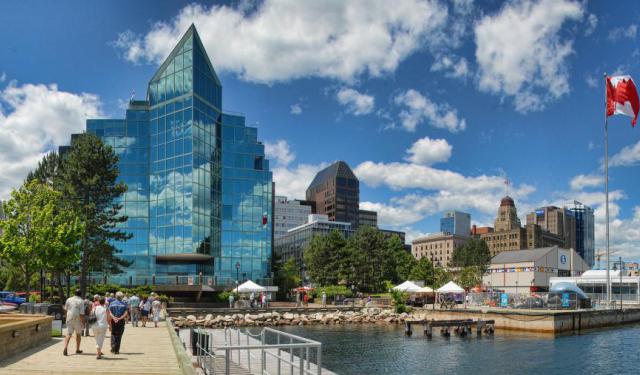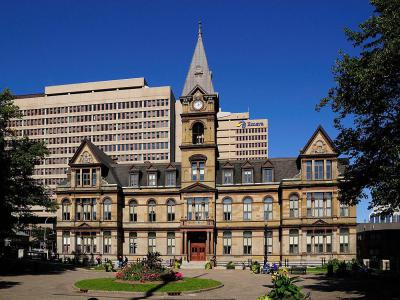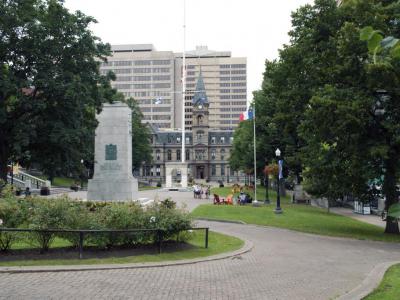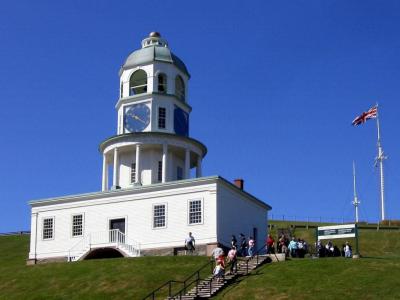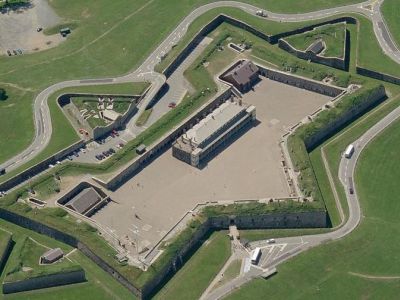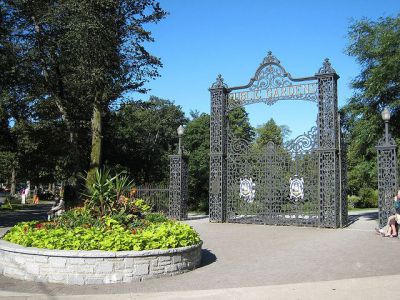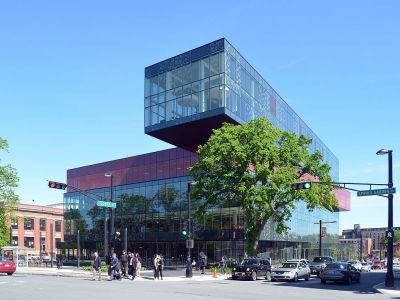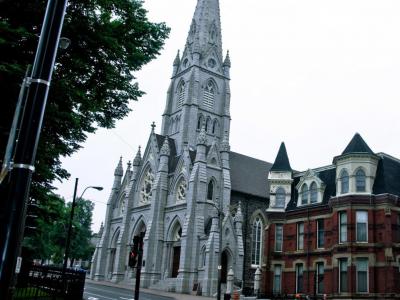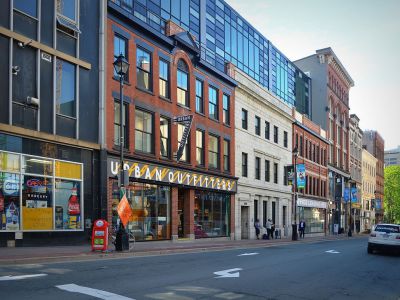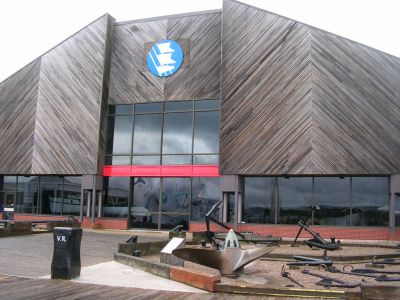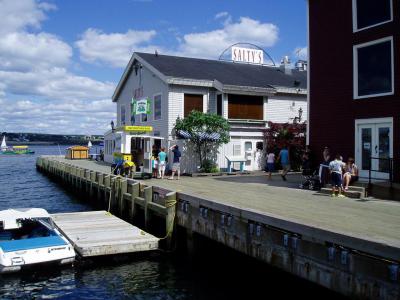Halifax Introduction Walking Tour (Self Guided), Halifax
Halifax is located on the ancestral lands of the Mi'kmaq who lived in the area long before Europeans arrived. Mi'kmaq called the area "Great Harbor". The city itself was established by the British in 1749 in violation of treaties with the Mi'kmaq. The establishment of the city led to Father le Loutre's War, otherwise known as the Anglo-Micmac War.
General Edward Cornwallis brought nearly 1,200 settlers to the new town of Halifax, which was named after the 2nd Earl of Halifax in England. Due to his success in extending American commerce, the Earl became known as "father of the colonies". Fortifications, such as that found at Halifax Citadel National Historic Site, were erected at that time.
The city has mostly remained peaceful since those early days. It has developed into a major cultural hub with symphonies, art galleries and museums throughout the city. There are a number of festivals that take place in Halifax, like the Atlantic Film Festival and the Halifax International Busker Festival.
Visitors to Halifax can learn more about how the city was founded by visiting the Halifax Citadel National Historic Site. A walk through the Grand Parade displays beautiful sculptures and memorials. Visitors will also want to see the Town Clock and City Hall.
Tourists flock to the town because of the oceanic climate and the beauty of the harbor. The Halifax Waterfront Boardwalk gives an excellent view of the Halifax waterway while also providing plenty of entertainment.
Take this self-guided walking tour to experience the history and beauty of Halifax.
General Edward Cornwallis brought nearly 1,200 settlers to the new town of Halifax, which was named after the 2nd Earl of Halifax in England. Due to his success in extending American commerce, the Earl became known as "father of the colonies". Fortifications, such as that found at Halifax Citadel National Historic Site, were erected at that time.
The city has mostly remained peaceful since those early days. It has developed into a major cultural hub with symphonies, art galleries and museums throughout the city. There are a number of festivals that take place in Halifax, like the Atlantic Film Festival and the Halifax International Busker Festival.
Visitors to Halifax can learn more about how the city was founded by visiting the Halifax Citadel National Historic Site. A walk through the Grand Parade displays beautiful sculptures and memorials. Visitors will also want to see the Town Clock and City Hall.
Tourists flock to the town because of the oceanic climate and the beauty of the harbor. The Halifax Waterfront Boardwalk gives an excellent view of the Halifax waterway while also providing plenty of entertainment.
Take this self-guided walking tour to experience the history and beauty of Halifax.
How it works: Download the app "GPSmyCity: Walks in 1K+ Cities" from Apple App Store or Google Play Store to your mobile phone or tablet. The app turns your mobile device into a personal tour guide and its built-in GPS navigation functions guide you from one tour stop to next. The app works offline, so no data plan is needed when traveling abroad.
Halifax Introduction Walking Tour Map
Guide Name: Halifax Introduction Walking Tour
Guide Location: Canada » Halifax (See other walking tours in Halifax)
Guide Type: Self-guided Walking Tour (Sightseeing)
# of Attractions: 10
Tour Duration: 2 Hour(s)
Travel Distance: 2.9 Km or 1.8 Miles
Author: DanaOffice
Sight(s) Featured in This Guide:
Guide Location: Canada » Halifax (See other walking tours in Halifax)
Guide Type: Self-guided Walking Tour (Sightseeing)
# of Attractions: 10
Tour Duration: 2 Hour(s)
Travel Distance: 2.9 Km or 1.8 Miles
Author: DanaOffice
Sight(s) Featured in This Guide:
- City Hall
- Grand Parade
- Town Clock
- Halifax Citadel National Historic Site
- Public Gardens
- Halifax Central Library
- Saint Mary's Basilica
- Barrington Street
- Maritime Museum of the Atlantic
- Halifax Waterfront Boardwalk
1) City Hall
Halifax City Hall was built in 1890. It was originally built to replace the old courthouse and for other public use. Halifax City Hall is notable for being one of the oldest public buildings in Nova Scotia. With four floors and a seven-story clock tower, it is also one of the largest.
The city hall was designed by architect Edward Elliot in the Late-Victorian Eclectic architecture style. The city hall building was built from the timbers of the demolished Dalhousie University, granite and sandstone laid in the freestone masonry technique.
The building underwent a major refurbishment in 2011. Most of the exterior stone was replaced along with the heating and cooling system and the elevator shaft. It was also wired for modern technology.
Visitors to Halifax will find the city hall conveniently located near many of the city's main attractions. It is a close walk to many historic sites, dining establishments, shopping boutiques and the harbor.
The city hall was designed by architect Edward Elliot in the Late-Victorian Eclectic architecture style. The city hall building was built from the timbers of the demolished Dalhousie University, granite and sandstone laid in the freestone masonry technique.
The building underwent a major refurbishment in 2011. Most of the exterior stone was replaced along with the heating and cooling system and the elevator shaft. It was also wired for modern technology.
Visitors to Halifax will find the city hall conveniently located near many of the city's main attractions. It is a close walk to many historic sites, dining establishments, shopping boutiques and the harbor.
2) Grand Parade
The Grand Parade is a military parade square that dates to 1749. The first contingent of British settlers in Halifax arrived in June 1749. Charles Morris, the Chief Surveyor, worked on the town layout which comprised an urban grid made up of oblong, rectangular city blocks with the Grand Parade at the center of the town.
The plan stipulated a church at southern end of the square, and a courthouse and prison at the northern end. The Saint Paul's Church opened in 1749. It was the first Protestant Church in Canada and is also the oldest building in Halifax. However, the north end remained vacant.
The parade is comprised of green space, statues and a memorial arch in honor of peace officers who fell in the line of duty. The Cenotaph is a sculpture located in the midst of the parade that gives honor to those who died in World War I.
Today the square is used for public events, concerts and special celebrations. Visitors can find a calendar of upcoming events at the City of Halifax website.
The plan stipulated a church at southern end of the square, and a courthouse and prison at the northern end. The Saint Paul's Church opened in 1749. It was the first Protestant Church in Canada and is also the oldest building in Halifax. However, the north end remained vacant.
The parade is comprised of green space, statues and a memorial arch in honor of peace officers who fell in the line of duty. The Cenotaph is a sculpture located in the midst of the parade that gives honor to those who died in World War I.
Today the square is used for public events, concerts and special celebrations. Visitors can find a calendar of upcoming events at the City of Halifax website.
3) Town Clock
The Town Clock, also known as the Old Town Clock or the Citadel Clock Tower, is one of Halifax’s most recognizable landmarks, perched on the eastern slope of Citadel Hill overlooking Brunswick Street. This historic clock tower, a reconstruction of an early 19th-century Palladian-style structure, remains a symbol of the city’s military past and architectural heritage.
The idea for the Town Clock was conceived by Prince Edward, Duke of Kent, who served as the commander-in-chief of British North America’s military forces. Concerned about punctuality within the British Army and Royal Navy garrison in Halifax, he commissioned a turret clock before his return to England in 1800. The clock was manufactured by the prestigious House of Vulliamy, a renowned London-based firm of Royal Clockmakers.
The Town Clock officially began keeping time for Halifax’s garrison on October 20, 1803 and continues to function with its original mechanism-an intricate system of three weights, gears, and a 13-foot pendulum housed in a cast-iron frame. The bell chimes every quarter-hour and hour, maintaining the discipline of timekeeping established over two centuries ago.
The clock tower is a three-tiered octagonal structure, sitting atop a one-story rectangular white clapboard base that adheres to Palladian proportions. The building’s symmetrical design features classic elements such as a round-plan colonnade, supporting the octagonal clock level, which in turn gives way to an arcaded upper story, crowned with a copper dome, balustrade, and a decorative copper ball.
The clock face, set on all four sides, features Roman numerals, with “4” traditionally written as “IIII” rather than “IV” for aesthetic balance. The clock’s slow-moving mechanism has contributed to its longevity, requiring twice-weekly manual winding by employees of Citadel Hill National Historic Site, under the care of Parks Canada.
A Halifax icon, the Town Clock has appeared in various artworks, literature, and television, including the children’s show Theodore Tugboat, where it was personified as Chimey. As a historic timekeeper, it continues to bridge Halifax’s past and present, standing as a testament to its craftsmanship and enduring legacy.
The idea for the Town Clock was conceived by Prince Edward, Duke of Kent, who served as the commander-in-chief of British North America’s military forces. Concerned about punctuality within the British Army and Royal Navy garrison in Halifax, he commissioned a turret clock before his return to England in 1800. The clock was manufactured by the prestigious House of Vulliamy, a renowned London-based firm of Royal Clockmakers.
The Town Clock officially began keeping time for Halifax’s garrison on October 20, 1803 and continues to function with its original mechanism-an intricate system of three weights, gears, and a 13-foot pendulum housed in a cast-iron frame. The bell chimes every quarter-hour and hour, maintaining the discipline of timekeeping established over two centuries ago.
The clock tower is a three-tiered octagonal structure, sitting atop a one-story rectangular white clapboard base that adheres to Palladian proportions. The building’s symmetrical design features classic elements such as a round-plan colonnade, supporting the octagonal clock level, which in turn gives way to an arcaded upper story, crowned with a copper dome, balustrade, and a decorative copper ball.
The clock face, set on all four sides, features Roman numerals, with “4” traditionally written as “IIII” rather than “IV” for aesthetic balance. The clock’s slow-moving mechanism has contributed to its longevity, requiring twice-weekly manual winding by employees of Citadel Hill National Historic Site, under the care of Parks Canada.
A Halifax icon, the Town Clock has appeared in various artworks, literature, and television, including the children’s show Theodore Tugboat, where it was personified as Chimey. As a historic timekeeper, it continues to bridge Halifax’s past and present, standing as a testament to its craftsmanship and enduring legacy.
4) Halifax Citadel National Historic Site (must see)
Halifax Citadel National Historic Site rests on Citadel Hill. The site was fortified in 1749 when the city was founded by the British. The Citadel was meant to defend Halifax Harbor and the Royal Navy Dockyard.
Four citadels have been built on Citadel Hill. The first came in 1749. It was a small redoubt, with a flagstaff and guardhouse near the summit. By 1761 its condition had deteriorated.
The second citadel was completed in 1776. It was a permanent fortification that could accommodate 100 troops. The British military presence in Halifax through Citadel Hill is thought to be one of the main reasons that Nova Scotia-the fourteenth British colony-remained loyal to the Crown throughout and after the American Revolutionary War.
However, poor construction caused the second citadel to fall into ruins in less than 10 years.
The third citadel was completed in 1796. It was larger than the previous two due to the oversight of Prince Edward, Duke of Kent. He had ordered the Citadel Hill be leveled in order to accommodate the larger space. This citadel lasted slightly longer than the others, but by 1825 it had fallen into disrepair.
The fourth and final citadel was built between 1828 and 1856. This massive masonry-construction fort was designed to repel both a land-based attack or attack from the water by United States forces. It was a star-shaped hillock citadel with internal courtyard and a clear harbor view from armored ramparts.
However the Halifax Citadel quickly became obsolete following the introduction of more powerful rifled guns in the 1860s. By the end of the 19th century, the role of the Citadel in the defense of Halifax Harbor had evolved as it was used as a command center for other, more distant harbor defensive works. It also provided barrack accommodations.
After the World War II, the fort began to decay but it was restored and opened as a living history museum and historic site in 1956.
Visitors can tour the Halifax Citadel throughout the year. They can expect different programs at the historic site depending on the time of year they arrive. From spring to fall, re-enactors are on the grounds of the Citadel portraying tradespeople, civilians and military forces from the late 19th century.
In the fall through Halloween, ghost tours are held at the fort. A Victorian Christmas celebration takes place every winter with crafts, games and Christmas carols.
Four citadels have been built on Citadel Hill. The first came in 1749. It was a small redoubt, with a flagstaff and guardhouse near the summit. By 1761 its condition had deteriorated.
The second citadel was completed in 1776. It was a permanent fortification that could accommodate 100 troops. The British military presence in Halifax through Citadel Hill is thought to be one of the main reasons that Nova Scotia-the fourteenth British colony-remained loyal to the Crown throughout and after the American Revolutionary War.
However, poor construction caused the second citadel to fall into ruins in less than 10 years.
The third citadel was completed in 1796. It was larger than the previous two due to the oversight of Prince Edward, Duke of Kent. He had ordered the Citadel Hill be leveled in order to accommodate the larger space. This citadel lasted slightly longer than the others, but by 1825 it had fallen into disrepair.
The fourth and final citadel was built between 1828 and 1856. This massive masonry-construction fort was designed to repel both a land-based attack or attack from the water by United States forces. It was a star-shaped hillock citadel with internal courtyard and a clear harbor view from armored ramparts.
However the Halifax Citadel quickly became obsolete following the introduction of more powerful rifled guns in the 1860s. By the end of the 19th century, the role of the Citadel in the defense of Halifax Harbor had evolved as it was used as a command center for other, more distant harbor defensive works. It also provided barrack accommodations.
After the World War II, the fort began to decay but it was restored and opened as a living history museum and historic site in 1956.
Visitors can tour the Halifax Citadel throughout the year. They can expect different programs at the historic site depending on the time of year they arrive. From spring to fall, re-enactors are on the grounds of the Citadel portraying tradespeople, civilians and military forces from the late 19th century.
In the fall through Halloween, ghost tours are held at the fort. A Victorian Christmas celebration takes place every winter with crafts, games and Christmas carols.
5) Public Gardens (must see)
The Public Gardens were established in Halifax in 1867. They are 16 acres of Victoria formal gardens. The gardens are comprised of a wide number of flower beds, three fountains, three ponds, two stone bridges and a number of statues.
In addition to the statues and flower beds, there are a number of plaques throughout the gardens. These plaques honor service members like Charles Carroll Wood, the first Canadian casualty of the Boer War. They also honor members of the Temperance movement who helped women gain the right to vote.
The Public Gardens was established in 1874 by combining two older gardens, the Nova Scotia Horticultural Society Garden (laid out in 1837) and an adjacent public park (opened in 1866). They are one of the finest surviving examples of a Victorian garden in North America. The Public Gardens were named a National Historic Site of Canada in 1984.
Free public concerts take place at the garden bandstand every Sunday in the summer. The Public Gardens also host large celebrations on Canada Day and Natal Day. The gardens are open from May 1 through November 1. The gates open at 8 AM. They begin closing one hour prior to sunset. The final gate closes 30 minutes before sunset.
In addition to the statues and flower beds, there are a number of plaques throughout the gardens. These plaques honor service members like Charles Carroll Wood, the first Canadian casualty of the Boer War. They also honor members of the Temperance movement who helped women gain the right to vote.
The Public Gardens was established in 1874 by combining two older gardens, the Nova Scotia Horticultural Society Garden (laid out in 1837) and an adjacent public park (opened in 1866). They are one of the finest surviving examples of a Victorian garden in North America. The Public Gardens were named a National Historic Site of Canada in 1984.
Free public concerts take place at the garden bandstand every Sunday in the summer. The Public Gardens also host large celebrations on Canada Day and Natal Day. The gardens are open from May 1 through November 1. The gates open at 8 AM. They begin closing one hour prior to sunset. The final gate closes 30 minutes before sunset.
6) Halifax Central Library
Halifax Central Library is a public library in downtown Halifax. It is the flagship library of the Halifax Public Library System. This library was completed in 2014 in a Modern architectural style designed.
The library is notable for its ultra-modern design. It has the appearance of multiple levels stacked atop each other at varying angles. This includes the fifth floor, which
juts over the plaza providing shade to the benches and tables below.
Along with books, the library offers community rooms, an auditorium and two cafes. The rooftop terrace is a popular spot for visitors to get a beautiful view of Halifax from a unique location.
The library is also home to public artwork created by Cliff Eyland. Eyland painted 5,000 miniature paintings on canvas the size of library cards, fittingly called "Library Cards." Before his death, Eyland also made a smaller version called "Book Shelf Paintings," which was comprised of 1,000 mini paintings.
The library is notable for its ultra-modern design. It has the appearance of multiple levels stacked atop each other at varying angles. This includes the fifth floor, which
juts over the plaza providing shade to the benches and tables below.
Along with books, the library offers community rooms, an auditorium and two cafes. The rooftop terrace is a popular spot for visitors to get a beautiful view of Halifax from a unique location.
The library is also home to public artwork created by Cliff Eyland. Eyland painted 5,000 miniature paintings on canvas the size of library cards, fittingly called "Library Cards." Before his death, Eyland also made a smaller version called "Book Shelf Paintings," which was comprised of 1,000 mini paintings.
7) Saint Mary's Basilica
Saint Mary's Cathedral Basilica is a Catholic cathedral in downtown Halifax. It is the largest Catholic church of the Archdiocese of Halifax. Though consecrated in 1899, it was made a basilica in 1950.
Construction of the original cathedral began in 1784 when laws forbidding Catholic worship in the region were repealed. The land was purchased and a wooden cathedral, then called Saint Peter's, was built. The current stone structure replaced the wooden building in 1820.
Saint Mary's was expanded in 1869. The facade was changed into a Norman-Gothic architectural style designed by Patrick Keely. This was when the spire was added to the building. Saint Mary's is noted for having the tallest granite spire in North America.
On 6 December 1917, a French cargo ship laden with high explosives, collided with the Norwegian vessel SS Imo outside of Halifax Harbor caused a massive explosion. The event is known as the Halifax Explosion. The interior of the cathedral suffered great damage during the explosion. Most of the cathedral's stained glass windows were shattered and some of the bells were cracked. Renovations have repaired the windows and restored the bells to their previous grandeur.
Saint Mary's is open during mass times to those who wish to take part in worship. Weekday masses take place from Monday through Friday at 12:15 PM. Sunday masses are at 8 AM, 10:30 AM and 5 PM.
Construction of the original cathedral began in 1784 when laws forbidding Catholic worship in the region were repealed. The land was purchased and a wooden cathedral, then called Saint Peter's, was built. The current stone structure replaced the wooden building in 1820.
Saint Mary's was expanded in 1869. The facade was changed into a Norman-Gothic architectural style designed by Patrick Keely. This was when the spire was added to the building. Saint Mary's is noted for having the tallest granite spire in North America.
On 6 December 1917, a French cargo ship laden with high explosives, collided with the Norwegian vessel SS Imo outside of Halifax Harbor caused a massive explosion. The event is known as the Halifax Explosion. The interior of the cathedral suffered great damage during the explosion. Most of the cathedral's stained glass windows were shattered and some of the bells were cracked. Renovations have repaired the windows and restored the bells to their previous grandeur.
Saint Mary's is open during mass times to those who wish to take part in worship. Weekday masses take place from Monday through Friday at 12:15 PM. Sunday masses are at 8 AM, 10:30 AM and 5 PM.
8) Barrington Street
Barrington Street is a street that follows the waterfront in Halifax. This primary city street runs from the MacKay Bridge to Inglis Street. At about seven-miles long, the street is an excellent one to enjoy when visiting the city.
Barrington Street is one of the original streets of Halifax. It was once the main commercial street in the city. Now, it is one of the primary streets for tourism.
Some of the notable places along Barrington Street include the Halifax Shipyard, Peace and Friendship Park, the Grand Parade, Halifax City Hall, Casino Nova Scotia, the Old Burying Ground, Province House and the Khyber.
Barrington Street has many places to eat and shop. An entire day can easily be planned simply walking from one end to the next while stopping at each of the interesting spots along the way. Due to its location near the water, it is easy for visitors to take a break away from the street and view boats coming in and out of the harbor.
Barrington Street is one of the original streets of Halifax. It was once the main commercial street in the city. Now, it is one of the primary streets for tourism.
Some of the notable places along Barrington Street include the Halifax Shipyard, Peace and Friendship Park, the Grand Parade, Halifax City Hall, Casino Nova Scotia, the Old Burying Ground, Province House and the Khyber.
Barrington Street has many places to eat and shop. An entire day can easily be planned simply walking from one end to the next while stopping at each of the interesting spots along the way. Due to its location near the water, it is easy for visitors to take a break away from the street and view boats coming in and out of the harbor.
9) Maritime Museum of the Atlantic (must see)
The Maritime Museum of the Atlantic, located in downtown Halifax, is Canada’s oldest and largest maritime museum. A member of the Nova Scotia Museum system, it boasts an extensive collection of over 30,000 artifacts, including 70 small craft and the historic steamship CSS Acadia. The museum also houses 30,000 photographs, a vast selection of charts, and rare books, making it a key institution for maritime history enthusiasts.
Originally founded in 1948 as the Maritime Museum of Canada, it was first based at HMC Dockyard in Halifax Harbour. The museum’s early years saw naval officers serving as volunteer chairs until 1959 when Niels Jannasch was appointed as its founding director, a role he held until 1985. Over the decades, the museum moved locations several times before settling into its current waterfront facility in 1981, as part of a redevelopment initiative. The CSS Acadia was acquired in 1982, further enriching the museum’s collection.
Situated on the Halifax Waterfront, the museum enjoys a prime location with piers, boatsheds, and a direct view of Halifax Harbour, including Georges Island and Dartmouth. Among its facilities is the restored Robertson Store ship chandler building, dating back to the 1880s, alongside the modern exhibit spaces of the Devonian Wing. During the summer months, the HMCS Sackville, a World War II Flower-class corvette, is docked adjacent to the museum, although it is not part of its administration.
The museum showcases maritime history through exhibits on sailing, steamships, small craft, the Canadian Navy, the Halifax Explosion, and shipwrecks. A standout is the Titanic exhibit, highlighting Nova Scotia’s role in recovering victims. It features the world’s largest collection of Titanic wooden artifacts, including a rare deck chair and children’s shoes that helped identify Sidney Leslie Goodwin as the “unknown child.”
Beyond its exhibitions, the museum actively engages in restoration projects. The boatsheds behind the museum house part of its small craft collection, including the ongoing restoration of Whim, a 1937 C-class sloop. In 2017, the museum completed the restoration of the small schooner Hebridee II. Three operational boats from the working small craft collection are moored next to CSS Acadia during the summer months.
The museum houses the Niels Jannasch Library, Canada’s largest ship portrait collection, and ship models, including Theodore Tugboat originals. A key part of Halifax’s culture, it showcases maritime history through exhibits and restoration projects.
Originally founded in 1948 as the Maritime Museum of Canada, it was first based at HMC Dockyard in Halifax Harbour. The museum’s early years saw naval officers serving as volunteer chairs until 1959 when Niels Jannasch was appointed as its founding director, a role he held until 1985. Over the decades, the museum moved locations several times before settling into its current waterfront facility in 1981, as part of a redevelopment initiative. The CSS Acadia was acquired in 1982, further enriching the museum’s collection.
Situated on the Halifax Waterfront, the museum enjoys a prime location with piers, boatsheds, and a direct view of Halifax Harbour, including Georges Island and Dartmouth. Among its facilities is the restored Robertson Store ship chandler building, dating back to the 1880s, alongside the modern exhibit spaces of the Devonian Wing. During the summer months, the HMCS Sackville, a World War II Flower-class corvette, is docked adjacent to the museum, although it is not part of its administration.
The museum showcases maritime history through exhibits on sailing, steamships, small craft, the Canadian Navy, the Halifax Explosion, and shipwrecks. A standout is the Titanic exhibit, highlighting Nova Scotia’s role in recovering victims. It features the world’s largest collection of Titanic wooden artifacts, including a rare deck chair and children’s shoes that helped identify Sidney Leslie Goodwin as the “unknown child.”
Beyond its exhibitions, the museum actively engages in restoration projects. The boatsheds behind the museum house part of its small craft collection, including the ongoing restoration of Whim, a 1937 C-class sloop. In 2017, the museum completed the restoration of the small schooner Hebridee II. Three operational boats from the working small craft collection are moored next to CSS Acadia during the summer months.
The museum houses the Niels Jannasch Library, Canada’s largest ship portrait collection, and ship models, including Theodore Tugboat originals. A key part of Halifax’s culture, it showcases maritime history through exhibits and restoration projects.
10) Halifax Waterfront Boardwalk (must see)
The Halifax Waterfront Boardwalk is a walking path that follows Halifax Harbor. The boardwalk is lined with shops, historic properties and tour boat operators. It is an excellent place for shopping, dining, getting some exercise or people watching.
Museums along the boardwalk include the Canadian Museum of Immigration at Pier 21, the Maritime Museum of the Atlantic and HMCS Sackville. Other interesting things to see along the boardwalk include Purdy's Wharf, the CSS Acadia, Bishop's Landing, the Samuel Cunard Monument and the Cunard Center.
The boardwalk features plenty of recreational space for young and old. There are hammocks, a dance floor and public art. The murals and sculptures reflect the sea and leisure activities. The Drunken Lampposts are a sculpture that show two lampposts displaying all of the fun that can be had at the local beer gardens.
The boardwalk stretches from Halifax Seaport to Casino Nova Scotia. It is about a two mile walk, making it an easy stretch any time of the day or night.
Museums along the boardwalk include the Canadian Museum of Immigration at Pier 21, the Maritime Museum of the Atlantic and HMCS Sackville. Other interesting things to see along the boardwalk include Purdy's Wharf, the CSS Acadia, Bishop's Landing, the Samuel Cunard Monument and the Cunard Center.
The boardwalk features plenty of recreational space for young and old. There are hammocks, a dance floor and public art. The murals and sculptures reflect the sea and leisure activities. The Drunken Lampposts are a sculpture that show two lampposts displaying all of the fun that can be had at the local beer gardens.
The boardwalk stretches from Halifax Seaport to Casino Nova Scotia. It is about a two mile walk, making it an easy stretch any time of the day or night.
Walking Tours in Halifax, Canada
Create Your Own Walk in Halifax
Creating your own self-guided walk in Halifax is easy and fun. Choose the city attractions that you want to see and a walk route map will be created just for you. You can even set your hotel as the start point of the walk.
Halifax Historical Buildings
Between the impressive waterfront and colorful, bustling streets, Halifax is a picturesque city. Much of its fascinating history is duly reflected in the local architecture. There are a number of historical landmarks in Halifax, including the time-honored buildings, palaces, and churches, where you can learn much about its glorious past.
The presence of these historical locations is bound to... view more
Tour Duration: 1 Hour(s)
Travel Distance: 1.6 Km or 1 Miles
The presence of these historical locations is bound to... view more
Tour Duration: 1 Hour(s)
Travel Distance: 1.6 Km or 1 Miles
The Most Popular Cities
/ view all
